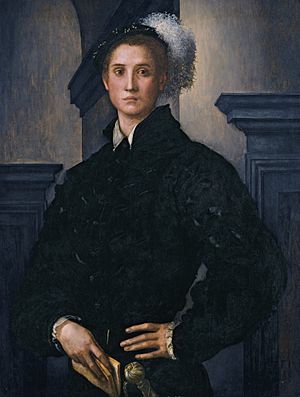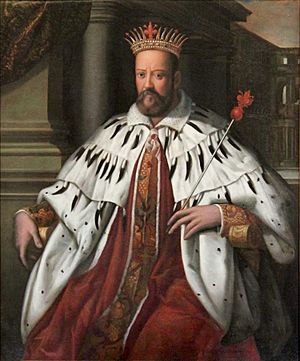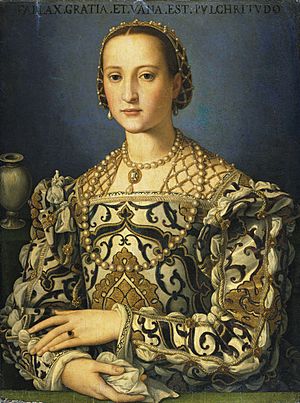Cosimo I de' Medici, Grand Duke of Tuscany facts for kids
Quick facts for kids Cosimo I de' Medici |
|||||
|---|---|---|---|---|---|
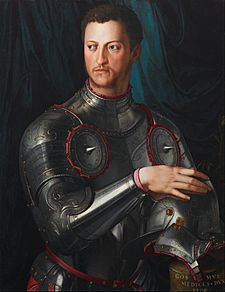
Portrait of Cosimo I de' Medici by Bronzino
|
|||||
| Duke of Florence | |||||
| Reign | 6 January 1537 – 21 August 1569 | ||||
| Predecessor | Alessandro | ||||
| Grand Duke of Tuscany | |||||
| Reign | 21 August 1569 – 21 April 1574 | ||||
| Successor | Francesco I | ||||
| Born | 12 June 1519 Florence, Republic of Florence |
||||
| Died | 21 April 1574 (aged 54) Florence, Grand Duchy of Tuscany |
||||
| Spouse | |||||
| Issue | Bia de' Medici Maria de' Medici Francesco I de' Medici Isabella, Duchess of Bracciano Cardinal Giovanni Lucrezia, Duchess of Modena Prince Pedricco Prince Garzia Ferdinando I de' Medici Anna de' Medici Prince Pietro Virginia, Duchess of Modena |
||||
|
|||||
| House | Medici | ||||
| Father | Giovanni delle Bande Nere | ||||
| Mother | Maria Salviati | ||||
| Religion | Catholicism | ||||
Cosimo I de' Medici (born June 12, 1519 – died April 21, 1574) was an important ruler in Florence, Italy. He started as the second Duke of Florence in 1537. Later, in 1569, he became the first Grand Duke of Tuscany, a title he held until his death.
Contents
Life of Cosimo I
Becoming a Ruler
Cosimo was born in Florence on June 12, 1519. His father was Giovanni delle Bande Nere, a famous military leader. His mother was Maria Salviati. Cosimo was also the grandson of Lorenzo the Magnificent, a very powerful figure in Florence's history.
In 1537, when Cosimo was just 17, he became the Duke of Florence. This happened after the previous duke, Alessandro de' Medici, was killed. Cosimo came from a different branch of the powerful Medici family. Many important people in Florence thought they could control him because he was young and not well-known.
However, Cosimo quickly showed he was strong and smart. He didn't let others control him. He took back the power that some people had tried to give to a special council.
When people who had been exiled from Florence heard about Alessandro's death, they tried to take over. They gathered an army with help from France. Cosimo sent his best soldiers to fight them at a place called Montemurlo in July 1537. Cosimo's army won this battle, and he celebrated his first big victory.
Ruling Tuscany
In 1537, Cosimo worked to get his position as ruler of Florence officially recognized. He got this approval from Emperor Charles V in exchange for helping him against France. This helped the Medici family stay in power in Florence for many years. Cosimo also wanted to make Tuscany more independent from other powerful countries like Spain.
Next, Cosimo focused on the city of Siena. With the Emperor's help, he defeated Siena's army in 1554. After a long siege, Siena fell in 1555. By 1559, Siena was fully part of Cosimo's lands. In 1569, Pope Pius V gave Cosimo an even higher title: Grand Duke of Tuscany.
In the last 10 years of his rule, Cosimo faced sadness when two of his sons died from malaria. After this, he let his son, Francesco I, take over the daily running of the state. Cosimo then spent more time at his villa, the Villa di Castello, outside Florence.
Cosimo's Leadership
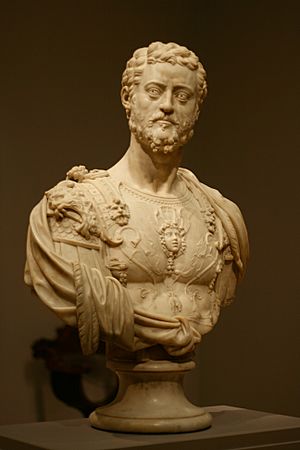
Cosimo was a strong leader. He hired Swiss soldiers to protect himself and his rule. He also worked to make sure Florence was safe from foreign armies. He built new forts and walls in cities like Siena, Arezzo, and Pisa. He also built strongholds on the island of Elba.
He asked his people to pay high taxes. But he also spent a lot of money supporting artists and building projects. He also created the Florentine navy. This navy later took part in the famous Battle of Lepanto. He put his new group of knights, called the Knights of St. Stephen, in charge of the navy.
Supporting the Arts
Cosimo is famous for creating the Uffizi building in Florence. This building was first used for government offices. Today, it is one of the world's most important art museums. It holds many artworks that the Medici family collected or asked artists to create.
His gardens at Villa di Castello were designed when he was only seventeen. They were meant to show Florence was entering a new golden age. These gardens had fountains, a maze, and a grotto (a small cave). They were a model for many other beautiful gardens in Italy and France.
Cosimo also finished building the Pitti Palace as a home for the Medici family. He also created the amazing Boboli Gardens behind the palace. Like his ancestors, he was a very important supporter of artists. He helped artists like Giorgio Vasari, Benvenuto Cellini, Pontormo, and Bronzino.
A large bronze statue of Cosimo I on horseback, made by Giambologna, still stands today in the Piazza della Signoria. This is the main square in Florence.
Cosimo was also interested in alchemy, which was a popular study at the time. He learned this interest from his grandmother, Caterina Sforza.
Family Life
In 1539, Cosimo married Eleanor of Toledo (1522 – 1562). She was a Spanish noblewoman. They had a long and happy marriage. Cosimo was very loyal to his wife, which was unusual for rulers at that time. Eleanor was also a trusted adviser to her husband. She often ruled Florence when he was away. She bought the Pitti Palace for the Medici family. She also supported the new Jesuit religious order.
Eleanor and two of her sons, Giovanni and Garzia, died in 1562. They all got malaria while traveling.
Cosimo and Eleanor had many children:
- Maria (1540 – 1557)
- Francesco (1541 – 1587), who became Grand Duke after Cosimo
- Giovanni (1543 – 1562), who became a cardinal
- Lucrezia (1545 – 1561)
- Pietro (Pedricco) (1546 – 1547), who died as a baby
- Garzia (1547 – 1562), who died at age 15
- Antonio (1548), who died as a baby
- Ferdinando (1549 – 1609), who became Grand Duke after Francesco
- Anna (1553), who died as a baby
- Pietro (1554 – 1604)
Before his marriage, Cosimo had a daughter named Bia de' Medici (around 1536 – 1542).
After Eleanor died, Cosimo had two more children with his partner Eleonora degli Albizzi:
- An unnamed daughter (born and died 1566)
- Giovanni (1567 – 1621)
In 1570, Cosimo married Camilla Martelli. They had one child together:
- Virginia (1568 – 1615)
See also
 In Spanish: Cosme I de Médici para niños
In Spanish: Cosme I de Médici para niños


